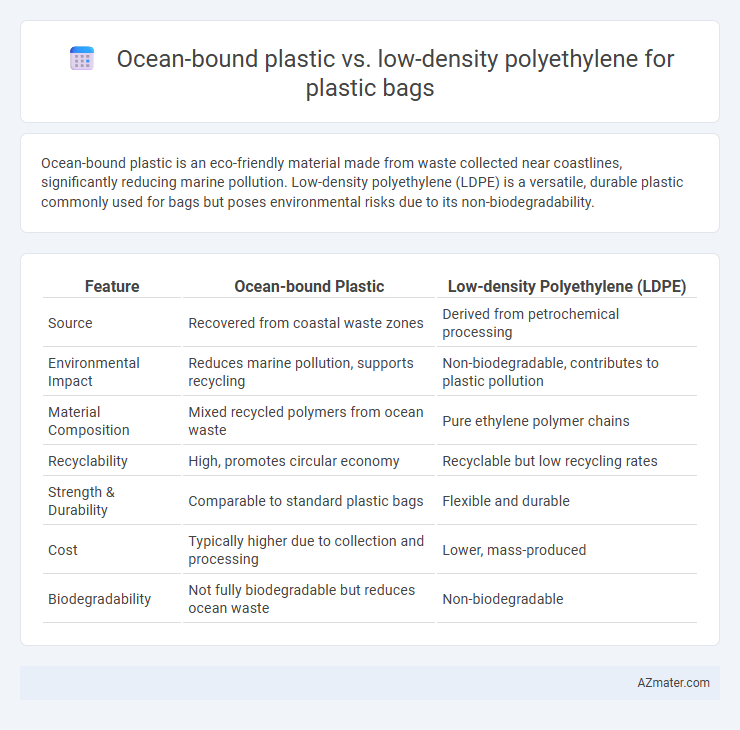Ocean-bound plastic is an eco-friendly material made from waste collected near coastlines, significantly reducing marine pollution. Low-density polyethylene (LDPE) is a versatile, durable plastic commonly used for bags but poses environmental risks due to its non-biodegradability.
Table of Comparison
| Feature | Ocean-bound Plastic | Low-density Polyethylene (LDPE) |
|---|---|---|
| Source | Recovered from coastal waste zones | Derived from petrochemical processing |
| Environmental Impact | Reduces marine pollution, supports recycling | Non-biodegradable, contributes to plastic pollution |
| Material Composition | Mixed recycled polymers from ocean waste | Pure ethylene polymer chains |
| Recyclability | High, promotes circular economy | Recyclable but low recycling rates |
| Strength & Durability | Comparable to standard plastic bags | Flexible and durable |
| Cost | Typically higher due to collection and processing | Lower, mass-produced |
| Biodegradability | Not fully biodegradable but reduces ocean waste | Non-biodegradable |
Introduction to Plastic Bag Materials
Ocean-bound plastic and low-density polyethylene (LDPE) serve as contrasting materials in plastic bag production, each with distinct environmental and functional profiles. Ocean-bound plastic originates from waste collected near coastal areas, repurposed to reduce marine pollution, while LDPE is a synthetic polymer widely used for its flexibility, durability, and moisture resistance. The choice between ocean-bound plastic and LDPE in plastic bags impacts sustainability efforts and performance characteristics, aligning production with eco-conscious consumer demands or conventional utility standards.
Understanding Ocean-Bound Plastic
Ocean-bound plastic refers to waste materials collected within 50 kilometers of coastal areas before entering the ocean, significantly reducing marine pollution. Low-density polyethylene (LDPE), commonly used in plastic bags, is a durable and flexible polymer, but its persistence in the environment contributes to plastic pollution. Utilizing ocean-bound plastic in manufacturing plastic bags provides an innovative solution by recycling coastal waste into functional products, thereby lowering the demand for virgin LDPE and mitigating ocean pollution.
Overview of Low-Density Polyethylene (LDPE)
Low-density polyethylene (LDPE) is a widely used thermoplastic polymer characterized by its flexibility, durability, and resistance to moisture, making it a preferred material for plastic bags in various industries. Unlike ocean-bound plastic, which is recycled from waste collected near coastal areas to reduce marine pollution, LDPE is primarily derived from the polymerization of ethylene monomers sourced from fossil fuels. The production and use of LDPE plastic bags present challenges in environmental sustainability due to their persistence in ecosystems and limited biodegradability compared to ocean-bound recycled alternatives.
Environmental Impact: Ocean-Bound Plastic vs LDPE
Ocean-bound plastic, sourced from waste collected near coastlines, significantly reduces marine pollution by intercepting debris before it enters oceans, thereby mitigating harm to marine ecosystems and wildlife. Low-density polyethylene (LDPE) bags, derived from non-renewable fossil fuels, contribute to long-lasting environmental pollution due to their slow biodegradability and prevalence in landfills and waterways. Utilizing ocean-bound plastic in bag production presents a circular economy solution that decreases plastic waste in marine environments, whereas LDPE bags exacerbate ecological damage through persistent environmental contamination and microplastic formation.
Production Processes and Resource Consumption
The production process of ocean-bound plastic bags primarily involves recycling collected plastics near coastlines, reducing raw material extraction and energy consumption compared to the synthesis of low-density polyethylene (LDPE) from petrochemicals. LDPE production requires significant fossil fuel inputs and high energy usage through polymerization of ethylene gas, contributing to carbon emissions and resource depletion. Ocean-bound plastic usage promotes circular economy practices by repurposing waste, while LDPE manufacturing relies heavily on virgin materials and intensive industrial processes.
Durability and Practicality of Both Materials
Ocean-bound plastic offers moderate durability with an eco-friendly edge, as it repurposes waste destined for marine environments, but it may have variable strength depending on its source. Low-density polyethylene (LDPE) is highly durable, flexible, and resistant to moisture, making it practical for plastic bags used in everyday retail and packaging applications. While LDPE ensures consistent performance and longevity, ocean-bound plastic bags contribute to sustainability efforts by reducing pollution even if they sometimes compromise on maximum durability.
Recycling and End-of-Life Considerations
Ocean-bound plastic offers a sustainable alternative for plastic bag production by repurposing waste collected near coastlines, which helps reduce marine pollution and supports circular economy initiatives. Low-density polyethylene (LDPE), commonly used in plastic bags, presents recycling challenges due to contamination and its lightweight nature, often leading to downcycling rather than closed-loop recycling. Effective end-of-life management for both materials requires advanced sorting technologies and increased consumer participation to enhance recycling rates and minimize environmental impact.
Cost Comparison: Ocean-Bound Plastic vs LDPE Bags
Ocean-bound plastic bags typically have higher production costs than low-density polyethylene (LDPE) bags due to the collection, cleaning, and processing involved in recycling ocean-bound materials. LDPE bags benefit from established manufacturing processes and economies of scale, making them significantly cheaper per unit. However, ocean-bound plastic bags offer environmental benefits that may justify their higher price in sustainable packaging markets.
Consumer Perceptions and Market Trends
Consumer perceptions increasingly favor ocean-bound plastic over low-density polyethylene (LDPE) for plastic bags due to heightened environmental awareness and demand for sustainable products. Market trends indicate a growing shift towards ocean-bound plastic bags as brands capitalize on eco-friendly credentials to attract environmentally conscious consumers. Sales data reveal that bags made from recycled ocean-bound plastics have higher growth rates compared to traditional LDPE bags, driven by government regulations and consumer pressure for reduced plastic pollution.
Future Prospects and Innovations in Plastic Bag Materials
Ocean-bound plastic offers a sustainable alternative to traditional low-density polyethylene (LDPE) by repurposing waste that would otherwise pollute marine environments, driving innovation in circular economy solutions. Emerging technologies enhance the durability and biodegradability of ocean-bound plastic-based bags, aligning with global regulatory trends toward reducing single-use plastics. Advances in polymer blending and bio-based additives promise to improve the mechanical properties and environmental footprint of plastic bags, positioning ocean-bound plastics as a key material in future eco-friendly packaging designs.

Infographic: Ocean-bound plastic vs Low-density Polyethylene for Plastic bag
 azmater.com
azmater.com